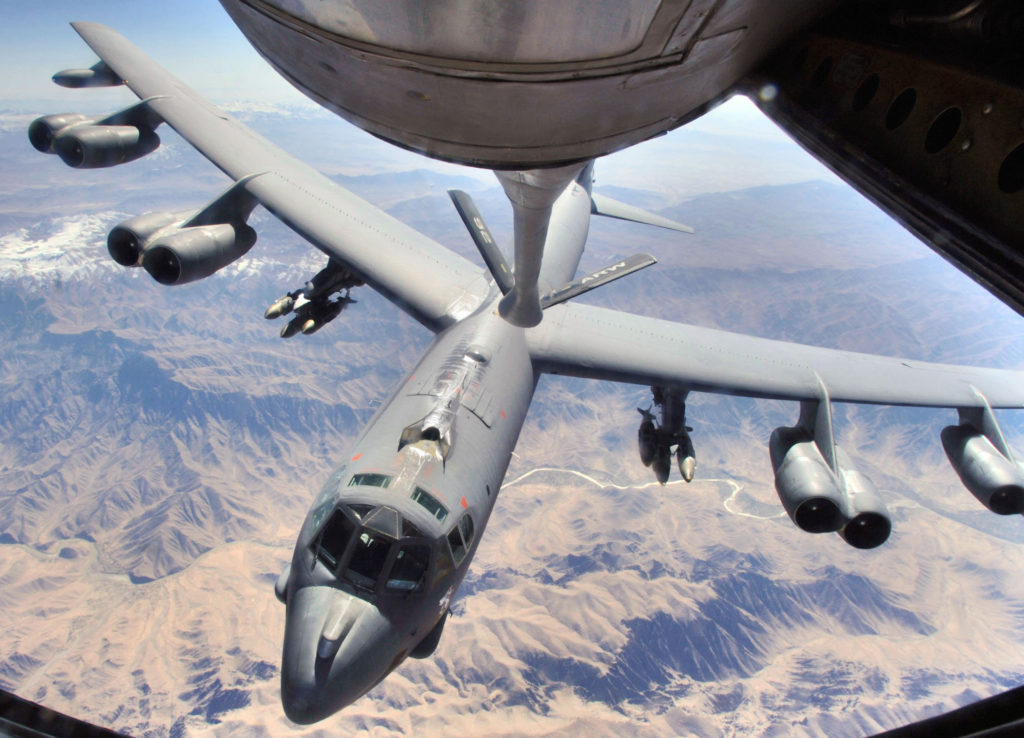The U.S. expanded its air campaign in northern Afghanistan, carrying out airstrikes against the Taliban in Badakhshan province near the border with China and Tajikistan.
“During these strikes, a U.S. Air Force B-52 Stratofortress dropped 24 precision guided munitions on Taliban fighting positions, setting a record of the most guided munitions ever dropped from a B-52. The aircraft has played a leading role in Air Force operations for decades, and was recently reconfigured with a conventional rotary launcher to increase its reach and lethality,” the NATO Resolute Support Mission said in a press release on Tuesday.
The strikes carried out over four days targeted Taliban training facilities and destroyed stolen Afghan National Army vehicles that were being converted into car bombs, “preventing the planning and rehearsal of terrorist acts near the border,” the force said.
The release comes a day after the Associated Press reported that U.S. troops and equipment were redeploying from Iraq to Afghanistan as the fight against Islamic State in Iraq shifts to a stabilization mission.
“More than 21,000 troops from 39 different countries, including NATO members and partners, contribute to the NATO-led Resolute Support Mission,” U.S. Navy Captain Tom Gresback, Public Affairs Director at Resolute Support headquarters, told The Defense Post on Tuesday.
“Approximately 14,000 of which are U.S. service members also committed the Freedom Sentinel Mission to assist with the fight against the enemies of Afghanistan and the Resolute Support Mission to train, advise and assist our Afghan partners.”


Renewed focus on air power
The latest strikes are part of an air campaign that began in November. New authorities from Washington give U.S. forces the ability to attack Taliban targets from the air, whereas they were previously confined to defending Afghan forces.
Read more: U.S. aerial war on drugs in Afghanistan fraught with risks
The new strategy includes cutting off the Taliban’s drug revenue by targeting production facilities. Last year opium production grew by 87 percent to a record 9,000 tons. U.S. agencies estimate that the Taliban makes about $200 million per year from opium production, and that about 500 production facilities exist in Afghanistan.
The U.S. estimates that the Taliban receives about 20 percent of revenues from drug traffickers in Afghanistan.
The U.S. used F-22 Raptor stealth fighters in Afghanistan for the first time in November when USFOR-A conducted a series of strikes on poppy production facilities in Helmand province.
“Increasingly, the Taliban have become a criminal organization. They fight, so they can keep profiting from their criminal activities: narco-trafficking, illegal mining, kidnapping and murder for hire,” USFOR-A commander General John Nicholson said at the time.
B-52s were used during the November run as well, at one point dropping 2,000 pound bombs to destroy a drug production facility and 50 barrels of opium.
Last month the U.S. deployed a squadron of A-10C Thunderbolt II ground attack aircraft to Kandarhar, returning the jet to Afghanistan to carry out airstrikes against the insurgents.
The Afghan Air Force is set to double its aircraft fleet over the next seven years. In October, the U.S. Air Force ordered six additional A-29 Super Tucano light aircraft for the Afghan Air Force, bringing its total to 26. The first six Afghan Air Force pilots qualified to pilot the UH-60 Black Hawk graduated from Aircraft Qualification Training on November 20.
The AAF also plans to introduce AC-208 attack aircraft and additional MD-530 attack helicopters.
The effectiveness of the new aerial bombing campaign has been called into question in recent days. A Special Inspector General for Afghanistan Reconstruction quarterly report released earlier this month challenged the Pentagon’s assertion that the strikes have cost the Taliban $16 million in lost revenue and should cost another $205,000 in future revenue per barrel.
According to SIGAR, the Defense Department has not stated whether that expectation is “calculated using price data on the export of opium and heroin, or using higher values in consumer markets outside Afghanistan.”
Furthermore, SIGAR said it had no information on how the Defense Department determined the quantity of the barrels at a particular location and whether they are full or empty. The value of seizures and destroyed equipment is based on U.S. Drug Enforcement Administration baselines.
“The labs being destroyed are cheap and easy to replace. Afghans told Reuters it would takes three or four days to replace a lab in Afghanistan,” the report said.


